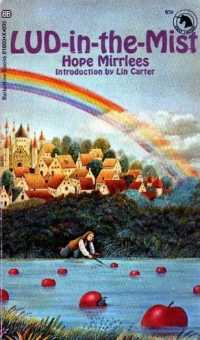Lud-in-the-Mist
|
cover of the 1970 reprint | |
| Author | Hope Mirrlees |
|---|---|
| Country | United Kingdom |
| Language | English |
| Genre | Fantasy novel |
| Publisher | Collins |
Publication date | 1926 |
| Media type | Print (Hardback) |
| Pages | 319 pp |
Lud-in-the-Mist (1926) is the third of three novels by Hope Mirrlees. It continues the author's exploration of the themes of Life and Art, by a method already described in the preface of her first novel, Madeleine: One of Love's Jansenists (1919): "to turn from time to time upon the action the fantastic limelight of eternity, with a sudden effect of unreality and the hint of a world within a world".
Whereas in Madeleine and The Counterplot Mirrlees took from historical figures, religions and literature the elements with which to build her stage, her use of a secondary-world setting in Lud-in-the-Mist links it to a tradition of high fantasy, and thence to its current locus of popularity. In 1970, an American reprint appeared without the author's permission, as part of the Ballantine Adult Fantasy series. It was subsequently reprinted by Orion Books in 2000 as part of their Fantasy Masterworks series.[1] A more recent republication by the Cold Spring Press includes a foreword by Neil Gaiman and an introduction by Douglas A. Anderson.[2]
Lud-in-the-Mist's unconventional elements, equally responsible for its appeal to the fantasy readership and distinction within the genre, are better-understood if they are taken in the context of her whole oeuvre. In this novel, the prosaic and law-abiding inhabitants of Lud-in-the-Mist, a city located at the confluence of the rivers Dapple and Dawl, in the fictional state of Dorimare, must contend with the influx of fairy fruit and the impact of the fantastic inhabitants of the bordering land of Faerie, whose presence and very existence they had sought to banish from their rational lives. When the denial proves futile, their mayor, the respectable Nathaniel Chanticleer, finds himself quite reluctantly at the center of the conflict and obliged to push beyond the boundaries of both his conventional life and those of Lud-in-the-Mist to find a reconciliation.[3]
Lud-in-the-Mist begins with a quotation by Jane Harrison, with whom Mirrlees lived in London and Paris, and whose influence is also found in Madeleine and The Counterplot. The book is dedicated to the memory of Mirrlees's father.
Reception
In a 1946 discussion of fantastic literature, Edward Wagenknecht referred to "Hope Mirrlees' unappreciated masterpiece Lud-in-the-Mist".[4]
David Langford and Mike Ashley describe Lud-in-the-Mist as "a moving book, shifting unpredictably from drollery to menace to a high poignancy that sticks in the mind".[5]
Neil Gaiman described Lud as "one of the finest [fantasy novels] in the English language. . . . It is a little golden miracle of a book." He described Mirrlees's writing as "elegant, supple, effective and haunting: the author demands a great deal from her readers, which she repays many times over."[6] He says that it is one of his top ten favorite books.[7]
Notes
- ↑ Brown, Charles N.; William G. Contento. "The Locus Index to Science Fiction (2000)". Retrieved 2008-02-20.
- ↑ Cold Spring Harbor, NY: Cold Spring Press (ISBN 1-59360-041-0), 2005
- ↑ E.L. Chapman, "Lud-in-the-Mist", in Frank N. Magill, ed. Survey of Modern Fantasy Literature, Vol. 2. Englewood Cliffs, NJ: Salem Press, Inc., 1983. ISBN 0-89356-450-8 . pp. 926-931.
- ↑ Edward Wagenknecht, "The Little Prince Rides the White Deer: Fantasy and Symbolism in Recent Literature", College English 7(8): 431-437. May 1946.
- ↑ David Langford and Mike Ashley, "Mirrlees, Hope", in St. James Guide To Fantasy Writers, ed. David Pringle, St. James Press, 1996, ISBN 1-55862-205-5,(p. 407-8).
- ↑ "Curiosities, F&SF, July 1999
- ↑ "Neil Gaiman's Top Ten", World Book Night, July 2011
References
- Bleiler, Everett (1948). The Checklist of Fantastic Literature. Chicago: Shasta Publishers. p. 201.
